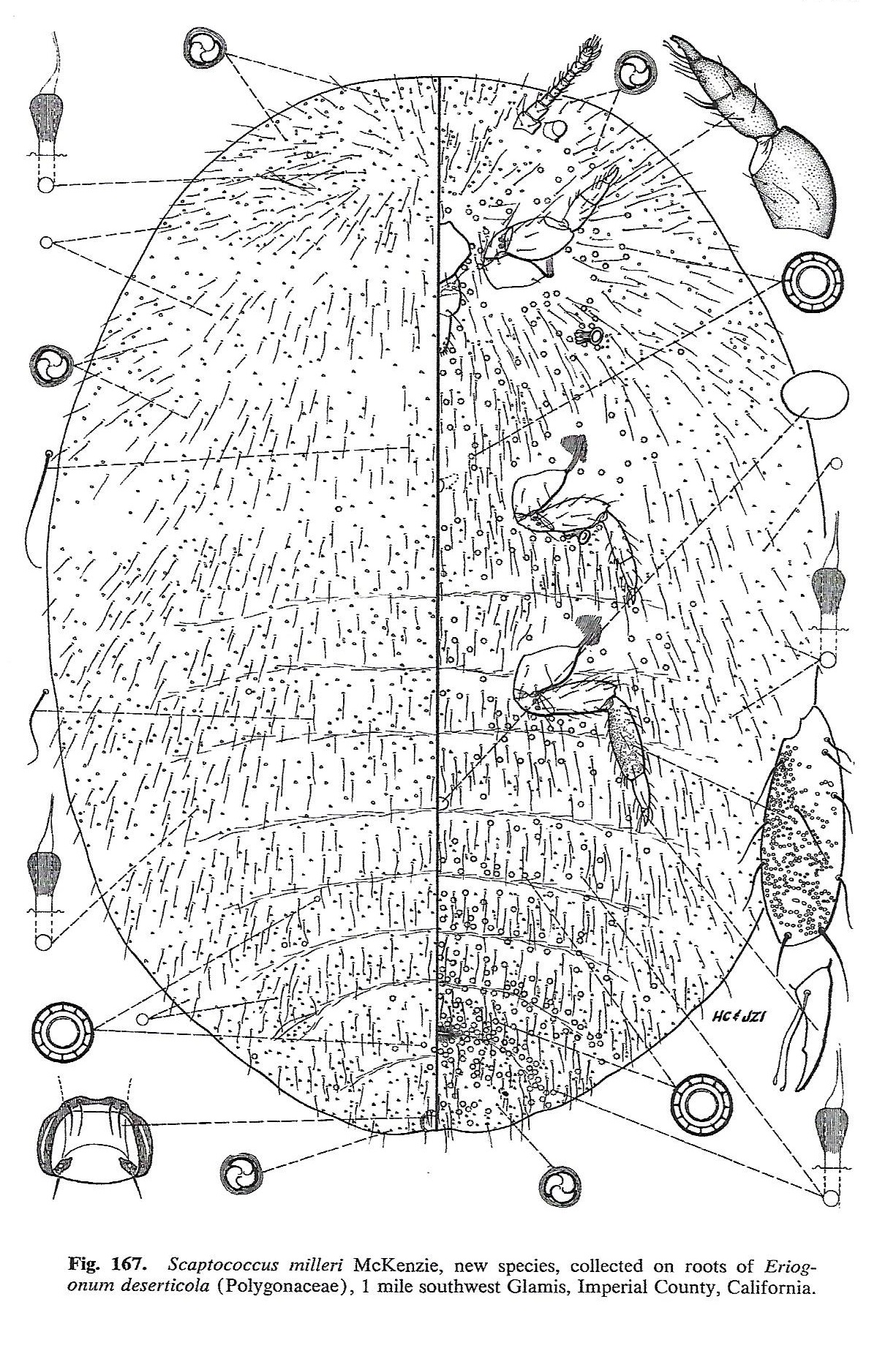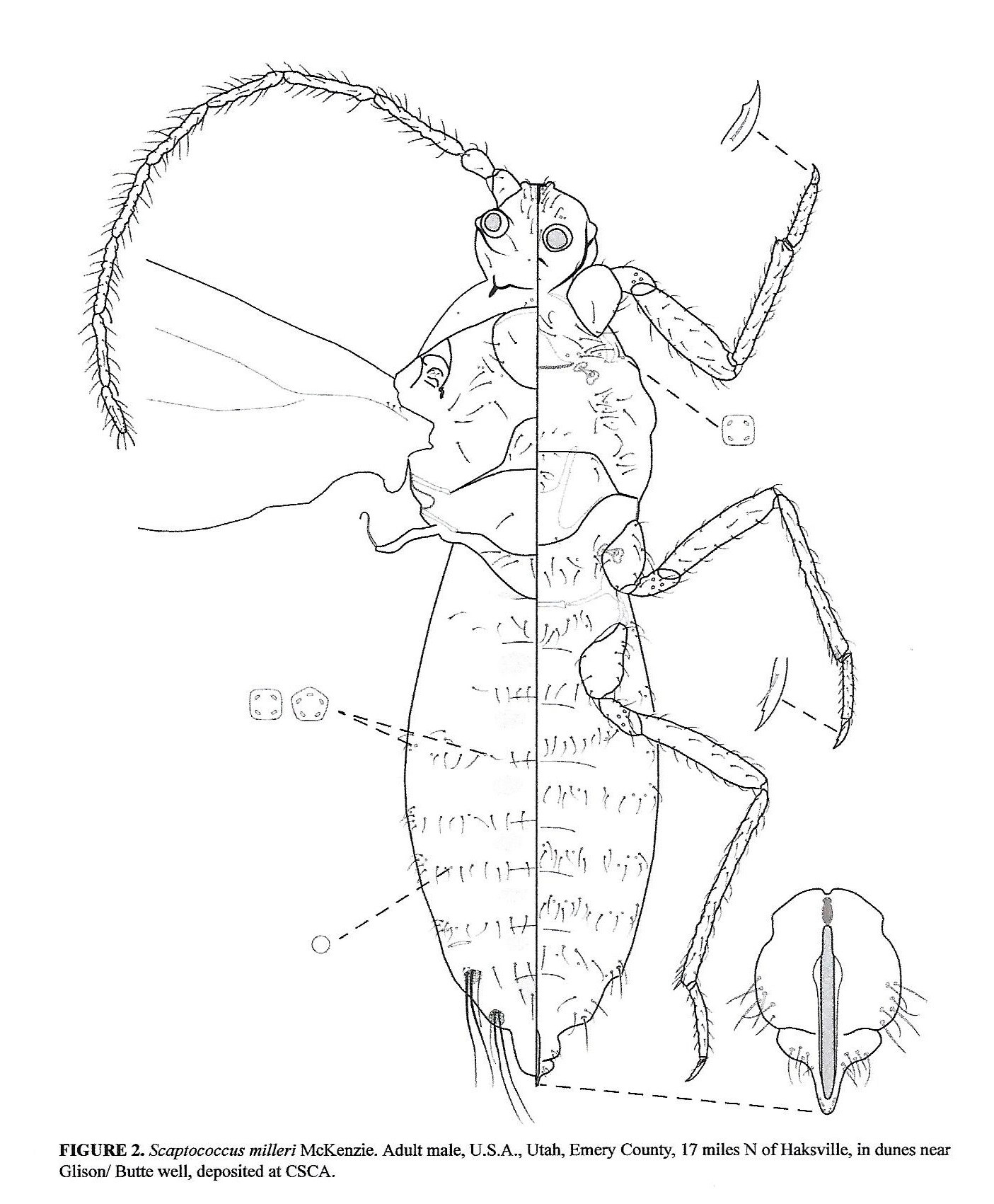Valid Names Results
Scaptococcus milleri McKenzie, 1967 (Pseudococcidae: Scaptococcus)Nomenclatural History
- Scaptococcus milleri McKenzie 1967: 407. Type data: U.S.A.: California, Imperial County, near Glamis, on Eriogonum deserticola. Holotype, female, Type depository: Davis: The Bohart Museum of Entomology, University of California, California, USA; accepted valid name Notes: Paratype, same data as holotype [CSCA]; 16 ♀♀ paratypes (11 adults, 5 immatures), same data as holotype but 8 miles W of Glamis, 23.xii.1965, D.R. & J.F. Miller leg. [BME]; 1 adult ♀ paratype, same data as holotype but 5.3 miles W of Glamis, 19.iii.1966, H.L. McKenzie leg. [BME]. Illustr.
Common Names
- Miller sand dune mealybug McKenz1967
Ecological Associates
Hosts:
Families: 4 | Genera: 5
- Asteraceae
- Ambrosia | VonEllWa2019
- Franseria | VonEllWa2019
- Fabaceae
- Psoralea | VonEllWa2019
- Malvaceae
- Malvaceae | VonEllWa2019
- Polygonaceae
- Eriogonum deserticola | BenDov1994 McKenz1967
Geographic Distribution
Countries: 1
- United States
- Arizona | BenDov1994 McKenz1967
- California | BenDov1994 McKenz1967
- Nevada | VonEllWa2019
- Utah | VonEllWa2019
Keys
- VonEllWa2019: pp.399 ( Adult (F) ) [Species of Scaptococcus]
- McKenz1967: pp.406 ( Adult (F) ) [U.S.A., California]
Remarks
- Systematics: Within Scaptococcus, the adult female of S. milleri can be recognized by the combination of stout legs (with prothoracic tibia + tarsus shorter than the femur) and the presence of a few dorsal multilocular and quinquelocular pores and modified oral collar tubular ducts scattered on the posterior abdominal segments (absent in S. californicus and not limited to posterior abdominal segments in S. occultans). Female nymphs can be recognized by the presence of a circulus (absent in S. californicus), anal ring with a single incomplete row of cellular pores (cellular pores absent in S. californicus and present in two rows in S. occultans), and forelegs stout, with prothoracic tibia + tarsus shorter than femur (prothoracic tibia + tarsus longer than femur in S. occultans). (von Ellenrieder & Watson, 2019)
- Structure: von Ellenrieder & Watson, 2019. amended McKenzie’s 1967 adult female description. Usually the antennae are 9-segmented, but are 8-segmented in several specimens. All the specimens possess quinquelocular pores interspersed among the multilocular pores, which are numerous on the venter of the thorax and abdomen, and are present in low numbers on the dorsum of SV–VIII. The antenna is 7-segmented in second-instar nymphs, and 8-segmented in third-instar nymphs. Both instars share with the adult female the presence of anterior and posterior ostioles, a plantar denticle on the claw, trilocular pores, quinquelocular pores, modified oral collar tubular ducts, long slender setae, a circulus, and a simplified anal ring with some cellular pores forming a single row. Besides lacking a vulva, they differ from the adult female by lacking multilocular pores. Body of adult male elongate oval, 1,800 μm long, maximum width of mesothorax 540 μm; fleshy setae not differentiated; all setae hair-like (flagellate with acute apices, longer setae proportionally slightly thicker than shorter ones); discoidal pores and multilocular pores present, the latter mostly each with 4 loculi, a few with 5 loculi. Antenna length three quarters of body length. Males macropterous, each wing as long as total body length and 0.36 times as wide as long. (von Ellenrieder & Watson, 2019)
- Biology: Occurring on the crown and roots of its host and found wandering in sand dunes (McKenzie 1967).
- General Remarks: Description and illustration of the adult female given by McKenzie (1967). McKenzie (1967) provided a color illustration of the adult female in its habitat and a color photograph.
Illustrations
Citations
- BenDov1994: catalog, 480
- McKenz1967: description, distribution, host, illustration, taxonomy, 407, 409-410
- VonEll2025: distribution, 34
- VonEllWa2019: biology, description, description of male, diagnosis, distribution, host, illustration, key, taxonomy, 388-392




